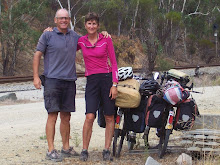Travelled E. on small mostly untarmaced country roads to Trujillo, through large fields of crops, & smaller fields divided by drystone walls. Red kites & Montagus Harriers in abundance. Some English birdwatchers pointed out a pair of Giant Bustards on the horizon; like big turkeys. Azure-winged magpies & hoopoes also plentiful. A large mobile phone aerial had been spiked to prevent storks nesting - this was no match for the intrepid stork, who had built her nest on the attached satellite receiving dish. This had been successful, as we could see a large chick poking its head over the edge.
Fields of white-faced sheep, some with lambs, & then dozens of black 'toros bravos' (fighting bulls). Just short of Trujillo we called at the tiny hilltop village of La Cumbre. Time has stood still here, with an ancient sturdy church, single storey white cottages, & untarmaced tracks. The one bar was full of old men playing cards. The village children gathered round us, practising their English & honking our bicycle horns.
Trujillo is a hilltop medeival town of chuches, palaces, convents & an arcaded Plaza Mayor hosting a 'Medieval Market'. Magnificent views of the surrounding plains from the town walls. Overwhelmed by the choice of local cheeses, we accidentely bought one which tasted of old goat. This is probably why, at our stop for lunch on the rio Tozo, we had at least 50 Griffen Vultures circling overhead.
We now had magnificent views of the mountains of the Monfrague Parque National, & once again are passing oak plantations with pigs grazing under as we head N. towards Plasencia. A good road surface sweeps up towards the mountains, passing occasional vineyards &, being a weekend, we encountered groups of lycra-clad cyclists.
Monfrague is a spectacular escarpment backed by mountains around the rio Tajo, dammed here to form a 100km long serpentine reservoir. A fantastic windy road snakes through, with many viewpoints to stop & watch the Black Vultures, Red Kite & Eagles. Just an amazing number of raptors all in the air together. Difficult to drag ourselves away, so arrived at 9pm at the excellent Monfrague Campsite, pitching next to some very friendly Flemish Belgians. Also met on site an English couple with a 'Thorn' bike, the same make as ours! In an adjoining field a red deer stag was sitting in the sun.
Plasencia is yet another town with a wealth of 13th & 14thC buildings. Ten cobbled narrow streets meet on the Plaza Mayor. Convents, churches, & houses of the rich with arcaded courtyards are set off shady plazas. The Parador vies with 'ours' at Zafra, being in a 14thC convent in the town centre, retaining magnificent vaulted ceiliings & arcaded courtyard. Tarried 3 nights on the Monfrague campsite, as the weather & bird-watching was wonderful. We cycled back into the Parque to have close views of vultures nesting & feeding their young at a large rock face adjacent to the dam.
Headed N. towards Bejar. Power pylons are protected here from storks by rows of poles with artificial nest sites. There are so many storks, however, that they still find places to squeeze nests onto the pylons. There is snow above about 1500m on the approaching Sierra de Candelario. We are the only occupants of the wooded campsite overlooking the quaint high village of Candelario. The cloud cover kept the temperature above freezing overnight. The next morning we past through the cobbled streets of timber-framed tile-hung houses in Candelario & the similar village of Navacarros.
We take the horribly busy N630 N. towards Salamanca, but before lunch find a way to the E. along country lanes by the full rio Tormes, in an area like the Somerset levels. We are relieved to reach the campsite 4km E. of Salamanca, as the strong side/head winds have been hard work.
Staying 2 nights here in order to visit the city, then moving E. towards Avila & Segovia.
skip to main |
skip to sidebar

About Us

- Sus and Mike
- In our retirement, cycling Europe (and elsewhere) before we get too old. This blog now has records of our tours of the UK (2007), Western Europe (2007/8), Australia (2008/9), UK to Hungary (2011), the Celtic Tour (spring 2012) and Pacific West Coast tour (Aug to Nov 2012).